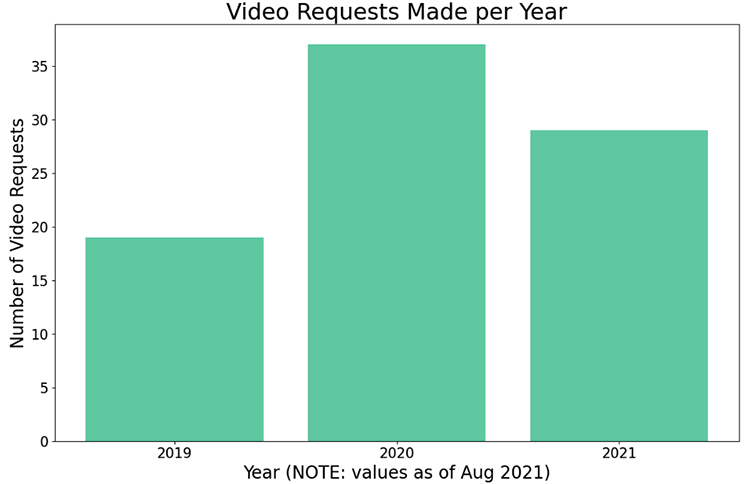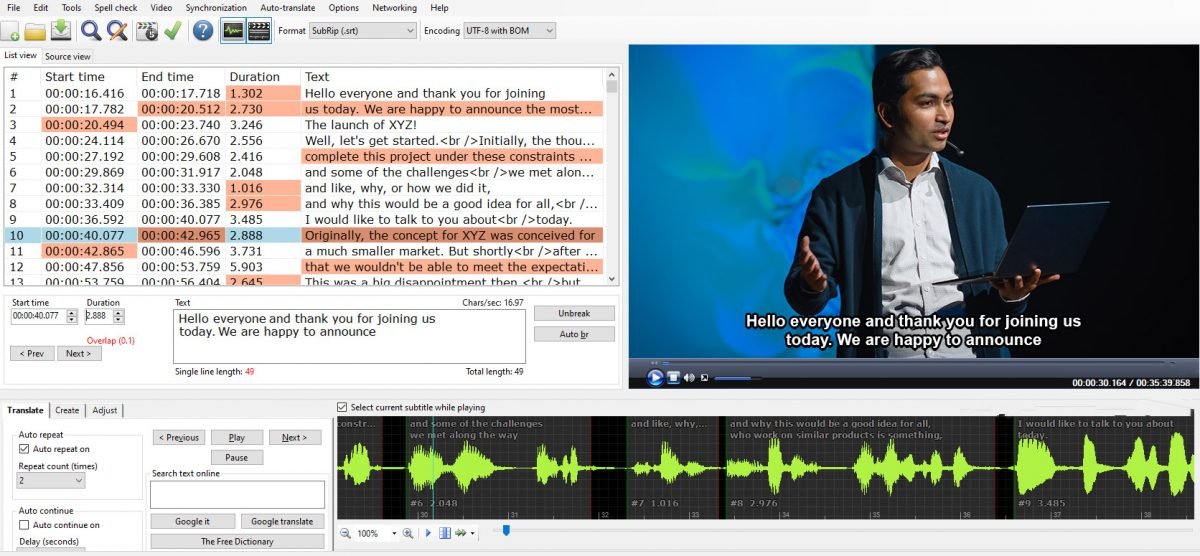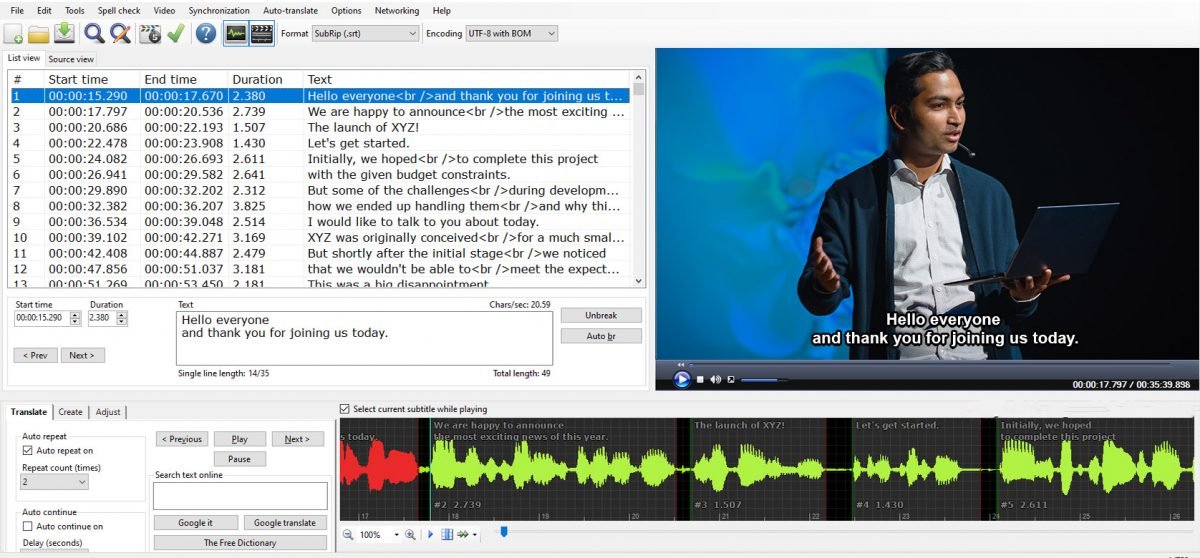If a picture says more than a thousand words,
a video communicates an entire library.
The greatest challenge of any online event is to keep audiences engaged and entertained without overwhelming them. Video plays a crucial role in this because they have become the most popular medium for people to retrieve information.
According to a 2020 study, 94% of consumers watched videos to learn more about a service or a product, and 83% would share these videos with friends if they spoke to their interest. Recognizing this preference, and the fact that no other method leads to more customer conversions or brand awareness, the number of businesses using video as an integral marketing tool has increased by 25% since 2016.
In the past eighteen months, this trend has accelerated and solidified as companies invested more of their marketing operations in online media due to COVID-19. Concordantly, the Blueprint Localization Team has seen a sharp uptick in requests to translate and localize online events and associated videos.

Video localization is essential to reach people all over the world and thus grow a company’s international customer base. A stunning 2.5 billion internet users come from Asia (with the majority from China), and 72.1% of people worldwide prefer websites translated into their native language. The same study shows that 44% of internet users in the E.U. fear missing important information when content is not translated into a language they understand, especially as many people watch videos muted and rely on subtitles and captions to convey what is being said on-screen.
Subtitles, therefore, need to be accessible, rendering speech concisely and coherently, so viewers can enjoy videos without missing information or having to piece together the message from a colorful mixed word salad with extra croutons.
While the above reports agree on the importance of video localization, only a few focus on the specific processes and additional steps required to achieve a successful product. Generally, the process looks like this:
- Transcription – the audio is converted to text unless there is an original script
- Timestamp – the transcript is timestamped to sync the captions with the audio
- QA review – the captions are reviewed in the original language
- Translation and localization – the captions are translated and localized into desired languages
- Balancing – individual lines and timestamps of video segments are adjusted to match localized subtitles
- QA review – the localized subtitles are reviewed
Blueprint provides subtitles for interviews and panel discussions, product demonstrations, tutorials, trailers and technical tips and tricks clients offer their target audience. Each format comes with unique challenges, but they can ultimately be boiled down to these four:
- The quality and accuracy of the original captions
- Video length, accuracy of timing and talking speed
- Grammatical relation between source and target language
- The complexity of the subject matter being localized
The quality and accuracy of the original captions
Our brains are designed to acquire and decode language. Together with our ears, they are marvelously skilled at processing stream-of-consciousness speech, where speakers interrupt, repeat and contradict themselves, lose the thread of what they wanted to say or insert a new thought somewhere along the way. Speed is also not much of an issue for an active listener, but human eyes can only read so many letters in a given time. As a result, it takes extra effort to convert spoken language into legible, comprehensive subtitles.
Many video creators rely on speech recognition software to create captions. Despite their ever-growing ability to correctly identify and transcribe human language, these machine learning models do not actually understand what the words they identify mean, let alone which parts of a lengthy unscripted sentence are relevant. The result often includes “unnatural” breaks (e.g. separating an article from a noun) and every spoken word — all the likes, wells and so thens. This, ultimately, is not what subtitles are about.

Unless a speaker is working with a script, it is often best for subtitlers to practice human judgment, parsing the original speech to determine the speaker’s core message for the audience before or as they begin translating.
Take the following phrase:
“Yes, well, like, you have events, like those I mentioned earlier, which are limited in time, and when, for example, like the big summer event that has a start and end date.”
Simplified, this statement could look like this:
“Many events, such as the summer event, run for a limited time.”
Video length, accuracy of timing and talking speed
Once your simplified lines are translated and shortened — while keeping all important information, of course — the subtitle translator must then merge and split sentences to balance the number of characters in a line, achieve natural breaks and modify the subtitles’ timestamps to ensure each subtitle segment is in sync with the audio. Streaming services and television channels set fixed character limits (how many characters per second and line) for subtitles, as well as a minimum and maximum duration for an individual subtitle to be on screen. These are determined by timestamps that designate the start and end viewing time of a subtitle segment. Adhering to these established best practices is essential for a comfortable viewing experience — viewers don’t want to be reading about a summer event when the speaker has moved on to a winter event. The longer the video, the more time is needed for this balancing act.
Instead of
Line 1 “We are looking forward to what our
Line 2 customers will say about the product.”
The following looks more natural and is easier to understand
Line 1 “We are looking forward
Line 2 to what our customers will say about the product.”

Another challenge is the length of the translation itself, as any UX designer or localization production artist will tell you. As a rule of thumb, a translation from English into most Romance languages like French or Spanish will be 15% to 30% longer. For Germanic languages, such as Dutch and German, it can exceed 35%.
Differences exist not only in phrase length but also in the length of individual words. Some languages such as Finnish, German and Dutch are well known for their wonderful compound words that replace a sequence of smaller words. Accordingly, the English phrase “Off-ear headphone settings” may become “off-earluidsprekerinstellingen” in Dutch. Whereas the English text could be broken up into two lines, separating them in Dutch poses a real challenge because excess hyphenation in subtitles should generally be avoided.
Grammatical relation between source and target language
Most translated and subtitled languages require adjustment of length and timing for many of the reasons cited above, but it is particularly challenging for Asian languages. While Romance and Germanic languages share some of English’s grammatical structure (subject-verb-object), Japanese, Chinese and Korean (subject-object-verb) often require a good deal more restructuring and reordering to achieve a natural flow and readability.
Many languages, especially those from Asia, also need to employ good cultural awareness and pay special attention to levels of formality in their translation. The casual use of first names and the personal pronoun “you” is often reserved for members of family and close friends and considered inappropriate in other contexts. Blueprint’s Korean localizers, for example, add honorifics and titles in front of names (e.g., Mrs., Prof.) for courtesy and use a more formal tone than that of the original audio, which lengthens lines by three to five characters.
The complexity of the subject matter being localized
Lastly, the complexity of any content will have a considerable impact on how easily and quickly it can be localized. Even someone who does not speak a second language can probably imagine how much simpler it might be to translate a grocery list versus the same number of words in technical documentation for an innovative new hardware product.
Every translation task is inherently a puzzle (except perhaps grocery lists) to be taken apart and re-assembled into a well-crafted, engaging whole. This is doubly true for videos. Exercising the special attention and skills necessary to correctly render this type of content in various languages is a unique challenge. But it can also be a lot of fun! There is something uniquely satisfying about seeing your work on YouTube or being streamed during an online event. To learn more about the work of Blueprint’s talented crew of puzzlers on the Localization team, visit us here.

